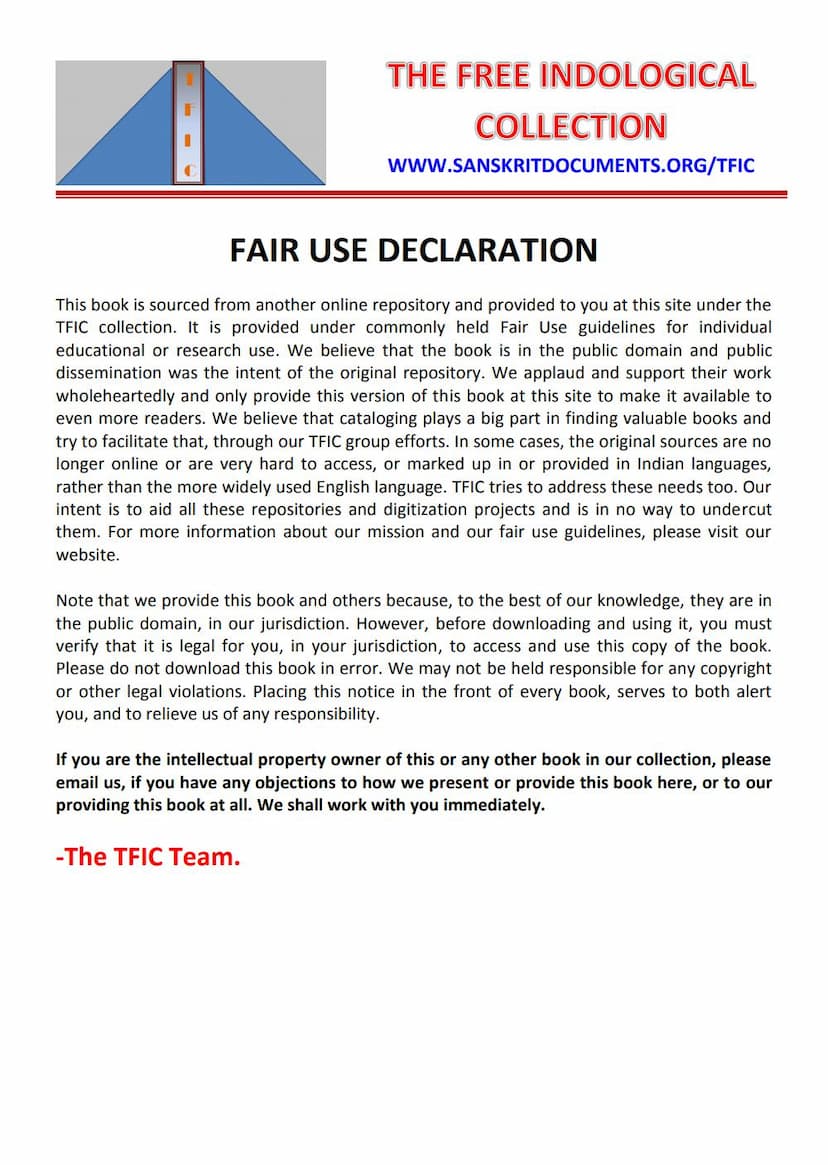Jain Kumar Sambhava Ka Adhyayan
Added to library: September 2, 2025

Summary
The book "Jain Kumar Sambhava ka Adhyayan" by Shyam Bahadur Dixit, published by Allahabad University, is a scholarly study of the Jain epic poem "Jain Kumar Sambhava" composed by Mahakavi Jayashekhar Suri. The study aims to provide a comprehensive analysis of this significant Jain literary work.
Here's a breakdown of the book's content, based on the provided chapter titles and descriptions:
Overall Scope: The book undertakes a detailed literary and critical examination of "Jain Kumar Sambhava," exploring its various facets from its Mahakavyatva (epic quality) to its influence on later works.
Key Areas of Study (Chapters):
-
Mahakavyatva of Jain Kumar Sambhava (The Epic Quality of Jain Kumar Sambhava):
- This chapter delves into the definition and characteristics of a Mahakavya (epic poem).
- It discusses the nature of poetry, its features, and the criteria that qualify a work as an epic.
- The chapter specifically analyzes how "Jain Kumar Sambhava" meets these epic standards. It also touches upon the concept of the poet (Kavi) and their role.
-
Life, Works, and Context of Jayashekhar Suri (Life and Works of the Author of Jain Kumar Sambhava and the Circumstances and Inspirations of Jain Poetry of that Period):
- This chapter focuses on the biography of Mahakavi Jayashekhar Suri, the author of "Jain Kumar Sambhava."
- It enumerates his various literary contributions and works.
- Crucially, it examines the political, social, religious, and literary conditions of the era in which Jain poetry was being produced, identifying the key inspirations behind its creation.
-
Origin and Influence on the Narrative of Jain Kumar Sambhava (The Origin of the Story of Jain Kumar Sambhava, its Plot, and its Influences):
- This chapter investigates the sources from which the narrative of "Jain Kumar Sambhava" was drawn.
- It details the plot of the epic, likely in a chapter-wise summary.
- The chapter also explores any potential influences on the composition of the work.
-
Character Analysis (Analysis of Characters in Jain Kumar Sambhava):
- This chapter provides an in-depth study of the prominent characters in the epic.
- It focuses on the protagonist, Rishabadeva (Lord Rishabhanatha), and his character portrayal.
- It also analyzes the contributions of the heroines, Sumangala and Sunanda, as well as supporting characters like Indra and his wife Sachi (or Angabhuta and Angabhuta Nayika Sachi, as mentioned).
-
Aesthetics of Jain Kumar Sambhava (Rasa, Chhanda, Alankara, Guna, and Dosha in Jain Kumar Sambhava):
- This chapter examines the aesthetic elements of the poem.
- It analyzes the dominant rasa (sentiment), primarily Shringara (erotic sentiment) and secondary rasas like Vatsalya (parental affection), Hasya (humor), Bhayanaka (terror), and Shanta (peace).
- The chapter discusses the seventeen types of chhandas (meters) employed in the epic.
- It also evaluates the presence of gunas (qualities like Madhurya and Prasad) and doshas (defects or flaws) in the poetry.
-
Artistic Aspects of Jain Kumar Sambhava (Critical Review of Jain Kumar Sambhava from an Artistic Perspective):
- This chapter offers a critical review of the poem based on its language, expression of emotions (bhava), imagination, and adherence to tradition.
-
Comparative Study of Jain Kumar Sambhava and Kalidasa's Kumar Sambhava (Comparative Study of Jayashekhar Suri's Jain Kumar Sambhava and Kalidasa's Kumar Sambhava):
- This is a significant chapter that draws parallels and distinctions between the Jain epic and Kalidasa's renowned Sanskrit epic.
- The comparison covers aspects like plot, language, style, qualities, embellishments (alankara), aesthetic appeal, depiction of nature, rasa, meter, and ornaments.
-
Jain Kumar Sambhava as a Source of Inspiration (Jain Kumar Sambhava as a Source of Inspiration):
- This chapter explores the influence of "Jain Kumar Sambhava" on subsequent literary works.
- It highlights how the epic served as a source of inspiration for later poets and their compositions.
-
Concluding Remarks and Appendices (Concluding Remarks and Appendices):
- This final chapter likely summarizes the findings of the research.
- It may also include a collection of significant aphorisms (Suktis) from the text, providing a concluding thought.
Key Themes and Contributions:
- Mahakavyatva: The study establishes "Jain Kumar Sambhava" as a genuine Mahakavya.
- Author and Context: It provides valuable insights into Jayashekhar Suri's life and the socio-historical and religious milieu that shaped Jain poetry.
- Narrative Sources: The research identifies the literary and religious texts that influenced the epic's storyline.
- Aesthetic Analysis: It offers a detailed breakdown of the poem's literary merits, including its portrayal of emotions, metrical structure, and use of rhetorical devices.
- Comparative Literature: The chapter comparing it with Kalidasa's "Kumar Sambhava" is crucial for understanding its place within the broader tradition of Indian epic poetry, highlighting both influences and distinct Jain characteristics.
- Inspirational Value: The study acknowledges the epic's role in inspiring later works.
In essence, "Jain Kumar Sambhava ka Adhyayan" is a meticulous academic work that seeks to bring a significant Jain epic to the forefront of literary scholarship, examining its artistic qualities, historical context, and comparative significance within Indian literature.